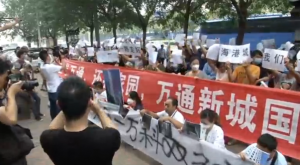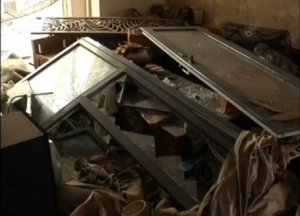
(Reuters) — Hundreds of angry residents whose homes had been destroyed in the Tianjin explosions gathered outside an official news conference venue on Monday (August 17), demanding answers.
People from a residential area near the blast site held banners reading “Give back our homes” and marched to a hotel where a government news conference was due to take place. The residents said they wanted answers from the government.
“Now our homes have been destroyed, can’t the government give us an explanation? You can’t just tell us all you are going to do is give us new windows, all they’re going to do is change the windows! What about all the other stuff in the house, why should we have to pay for this?” said 60-year-old Mrs. Wang.
“Have a look at the destruction in my home, the window fell directly onto the bed at the time someone in my family was in that bed, luckily they immediately ran out, otherwise they would have been killed,” said 30-year-old Mrs. Wang, showing a photo of her damaged home on a mobile phone.
“We just want to say that so far the media hasn’t mentioned us, we feel like we’ve been forgotten, we just want to say that there are still us, that’s all,” said 39-year-old Li Chengze.

The death toll from the two blasts on Wednesday (August 12) has risen to 114 as of 0300 GMT on Monday and 70 people, most of them fire fighters, are missing, state media said, suggesting the toll will rise significantly.
Nearly 700 people remained in hospital four days after Wednesday’s disaster, which sent massive yellow and orange fireballs into the sky, rained burning debris on to a vast industrial zone, crumpled cars and shipping containers, burnt out buildings and shattered windows of nearby apartments.
Soldiers and rescue workers in gas masks and hazard suits continued to search for toxic materials at the blast site, the goal is to clear the chemicals before any rain falls, which could create further toxic gas.
Officials acknowledged the presence of toxins but said they posed no risk to people outside a two-km evacuation zone surrounding the blast area.
Some 6,300 people have been displaced by the blasts.







